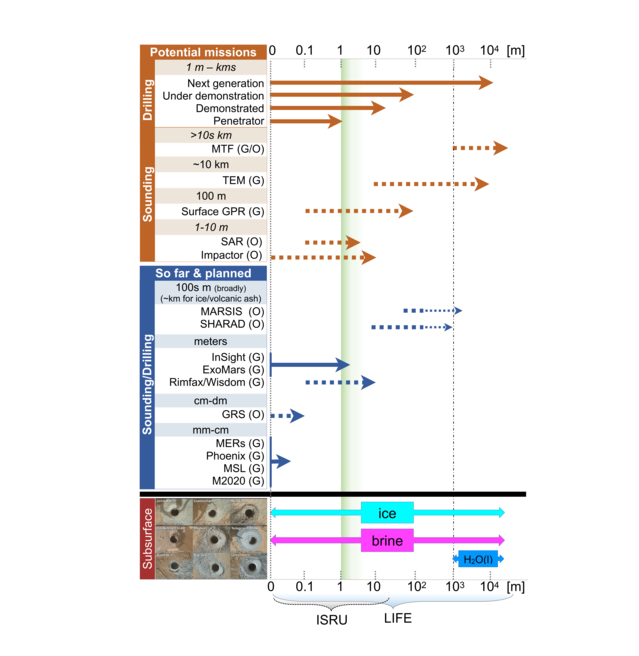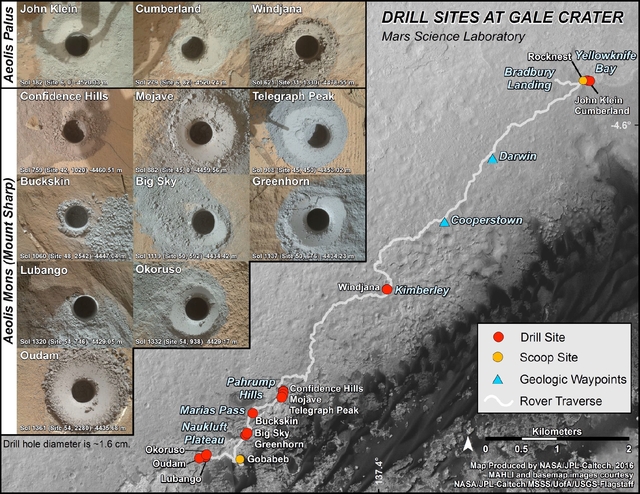Research Highlights
The Next Frontier for Planetary and Human Exploration
In January 2019, fifty scientists from thirty institutes across the world, led by Dr. Vlada Stamenković from JPS/NASA, including Dr. Atsuko Kobayashi and Prof. Joe Kirschvink from ELSI, published an invited commentary on the next frontier for planetary and human exploration in Nature Astronomy. They highlighted how the exploration of the Martian subsurface, to depths from a few meters to many kilometres, offers an unprecedented opportunity to answer one of the biggest questions contemplated by humankind; was or is there life beyond Earth? This claim is based on the fact that the Martian subsurface might have been the longest-living habitat on Mars, is the most likely (if not only) environment on Mars today that could still sustain life, and has a much greater potential for preserving signs of ancient, extinct life than the surface. Moreover, the authors argue how Mars subsurface exploration with a focus on habitability also lays the foundation for self-sufficient human settlements beyond our own planet, as the latter inevitably rely on first characterizing the inventory and distribution of Martian subsurface resources.
 Sounding and drilling capabilities on Mars. The sounding depths are plotted in dashed arrows and the drilling depths in solid arrows, for missions that have already been delivered to Mars or are scheduled (navy blue) versus selected potential instruments that could help explore the Martian subsurface (orange). Image credit: Dr. Vlada Stamenković.
Sounding and drilling capabilities on Mars. The sounding depths are plotted in dashed arrows and the drilling depths in solid arrows, for missions that have already been delivered to Mars or are scheduled (navy blue) versus selected potential instruments that could help explore the Martian subsurface (orange). Image credit: Dr. Vlada Stamenković.
In order to enable Mars subsurface exploration, the authors show that we can build upon three pillars: (1) new technology, (2) 4D science and (3) new and old commercial sectors. Technological innovations encompass miniaturized time-domain electromagnetic techniques that can detect liquid water at kilometer depths whilst weighing only a few kilograms, orbital SAR with polarimetry that can globally scan for shallow ices, and drills that could today reach a few meters of depth under Mars conditions; while wireline systems, 3D printing, compressed CO2, and well-established sampling techniques could in the near future help drill to a kilometre in a Martian year under sterile conditions. Technological innovations are enhanced by 4D science (in 3D space and in time), from ongoing global monitoring of potential subsurface features of interest to a better global understanding of Mars subsurface environments across time and space using global climate and geodynamic hydrological/crustal evolution models. Ultimately, next to technological and scientific advancements, synergistic collaborations with the rising commercial space sector and traditional mining companies, which have great interest in exploring and utilizing Mars subsurface resources, and a new emerging class of more affordable self-propelled small spacecraft, may both reduce costs and increase the frequency of opportunities to reach Mars.
As such, the emerging capabilities of Mars subsurface science and exploration technology in combination with the commercial space market have positioned the Martian underground as the next great frontier of human endeavours. A "deep" endeavour that could hold an essential key in answering the question of how life started on the Earth and whether we are alone in the Universe.
Invited commentary in Nature Astronomy on the next frontier for planetary and human exploration led by Dr. Vlada Stamenković (JPL/NASA) et al. including ELSI co-authors Dr. Atsuko Kobayashi (ELSI) and Prof. Joe Kirschvink (Caltech/ELSI). The next frontier for planetary and human exploration presents an "underground" strategy for the search for life on Mars.
| Journal | Nature Astronomy |
| Title of original paper | The next frontier for planetary and human exploration |
| Authors | V. Stamenković1*, L. W. Beegle1, K. Zacny2, D. D. Arumugam1, P. Baglioni3, N. Barba1, J. Baross4, M. S. Bell5, R. Bhartia1, J. G. Blank6,7, P. J. Boston7, D. Breuer8, W. Brinckerhoff9, M. S. Burgin1, I. Cooper10, V. Cormarkovic1, A. Davila7, R. M. Davis11, C. Edwards1, G. Etiope12,13, W. W. Fischer14, D. P. Glavin9, R. E. Grimm15, F. Inagaki16,17, J. L. Kirschvink14,18, A. Kobayashi18, T. Komarek1, M. Malaska1, J. Michalski19, B. Ménez20, M. Mischna1, D. Moser21, J. Mustard22, T. C. Onstott23, V. J. Orphan14, M. R. Osburn24, J. Plaut1, A.-C. Plesa8, N. Putzig25, K. L. Rogers26, L. Rothschild7, M. Russell1, H. Sapers1, B. Sherwood Lollar27, T. Spohn8, J. D. Tarnas22, M. Tuite1, D. Viola28, L. M. Ward29, B. Wilcox1 and R. Woolley1. |
| Affiliations |
1. Jet Propulsion Laboratory, California Institute of Technology, Pasadena, CA, USA. |
| DOI | 10.1038/s41550-018-0676-9 |
| Online published date | Jan.14, 2019 |













